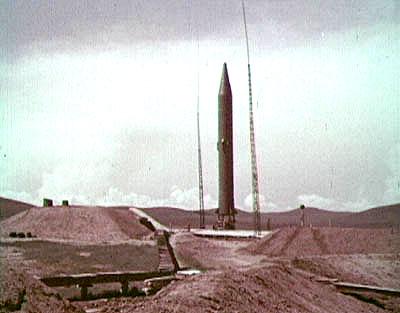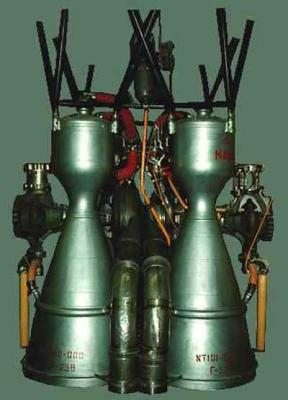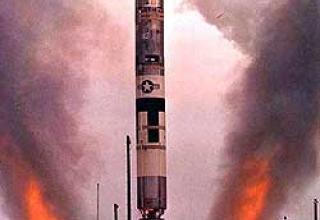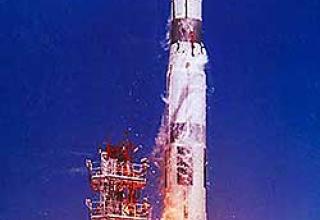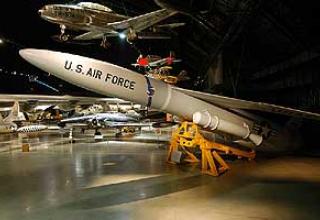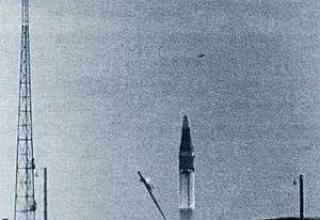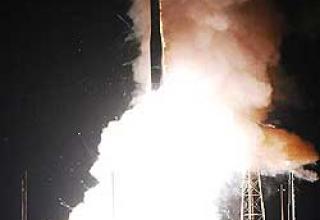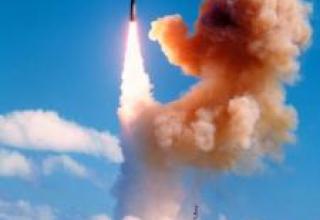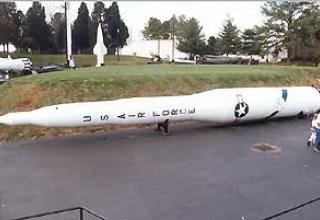The R-12 flight test program has not yet been completed, when it became clear that it is necessary to create a missile capable of covering the entire range of medium-range. The information that the United States is testing ballistic missiles with a range of more than 3,000 km only accelerated the decision. July 2, 1958 MK Yangel Design Bureau received a government assignment to design a missile with a range of 3600 km and higher than the R-12 performance. The design team that had gained sufficient experience by that time was able to successfully solve the task within two years.
On July 6, 1960 at the Kapustin Yar Range the first test launch of a new missile, designated 8K65, was held. It was found to be a success. But the first series of tests revealed the phenomenon of cavitation, which led to the destruction of missiles. This problem was dealt with quickly, allowing the entire test cycle to be completed on February 15 next year. On April 24, 1961, the new MRBM was adopted by the Strategic Missile Forces. January 1, 1962 in the town of Glukhov began on duty the first missile regiment, armed with a missile system with BRSD 8K65. On the same day the first division of the missile regiment stationed in Priekule began to be on duty.
The 8K65 missile was launched from a ground-based launcher. Filling and aiming the missile was carried out after its installation on the launching table. The designers managed to achieve a higher readiness of the rocket for launch as compared to previously accepted rocket samples.
The desire to improve the survivability led to the development of a silo-based version of the missile - 8K65U. For the missile in the version 8K65U were created silo launchers "Chusovaya", structurally similar to SHPU "Dvina". Modified missile was more advanced than 8K65. It was equipped with a remote control system for refueling and compressed gases. The SHU had significant advantages over ground-based launches in terms of protection against nuclear blast hazards, as well as ensured the long-term maintenance of the missiles in readiness for launch.
The first launch of the upgraded 8K65U rocket took place on February 11, 1962. Tests were conducted at the Kapustin Yar range, where a special silo launcher was built. In October of the following year they were successfully completed, and the new missile was adopted by the Strategic Missile Forces and operated until the mid-80s. The last R-14U missile was eliminated in accordance with the provisions of the DSMD Treaty.
Serial production of 8K65 and 8K65U missiles was carried out at plants No. 586 and No. 1991.
Composition:
The R-14 missile system includes the following combat vehicles:
- 8K65 missile
- Launching unit 8U235
- Missile installer 8U224 (8U224M)
Rocket 8K65 - a single-stage rocket with carrying fuel tanks. The missile's fuel tanks are made of pressed finned panels. The "O" tank is inflated with air, the "G" tank - with nitrogen. Nitric acid (oxidizer) and asymmetric dimethylhydrazine (fuel), which were ignited by mutual contact, were used for the first time as components of rocket fuel. For the first time, membrane valves were also installed in the lines of each of the rocket fuel components, separating the rocket engine from the fuel tanks, which allowed to keep the rocket filled up for a long time.
The 8K65 had an autonomous inertial control system. For the first time a gyrostabilized platform with air suspension of gyroscopes was used, as well as a program pulse generator. The GSP-NII-49 developer used gas-jet steering wheels as controls.
The missile was equipped with a monoblock nuclear head unit of 1 Mt capacity which was separated in flight. In order to prevent the missile body from colliding with the head end in the first seconds after separation, three powder brake rocket engines were used, which were switched on at the time of the end of the marching LRBM. The missile had systems of emergency detonation of the HC and shutdown of the remote control in case of a significant deviation of the missile from the given flight path.
The 8K65U missile was unified for ground and silo launch. The method of launch from the mine - free, gas-dynamic, from the starting cup, on its own engines. The mine combat launch complex consists of three control panels and a command post. A division with ground combat launches consists of three batteries and has one launcher in each battery.
The rocket was equipped with the RD-216 marching engine, which consisted of two identical engine blocks 8D513, combined with the frame mount with the hull and have a common starting system, each of which had two combustion chambers, a turbo pump unit (TNA), a gas generator running on the main fuel components and an automation system.
Combustion chambers of solder-welded design with internal and regenerative cooling. The chamber body is formed by two shells - a fire bronze wall and a steel jacket, which are connected through corrugated spacers.
For the first time, the TNA operated on the main fuel components, which made it possible to eliminate the use of hydrogen peroxide and simplify the rocket operation. The TNA contained two double-entry fuel-screw centrifugal pumps and an axial two-stage active turbine located on two shafts. The gas for the TNA drive was produced in the gas generator by burning a small part of the fuel with excess fuel. The used gas was emitted by the turbine pumping unit through a special nozzle.
Automatic units were triggered by electric and pyrocommand, as well as nitrogen control pressure, which was fed to the gearbox from on-board cylinders. The LPD was regulated by the traction by changing the fuel consumption through the gas generator, by the ratio of fuel components - by changing the oxidizer consumption. The traction vector was controlled with the help of gas steering wheels.
Start-up of LRD - single-stage, with the initial supply of components in gas generators blocks of two starting tanks by displacing them with nitrogen through the ground starting airbags.
Traction control in flight was carried out by simultaneous change of both components' supply to gas generators while maintaining their ratio and stabilization of generator gas temperature. It was carried out by hydro-reducers of oxidizer and fuel, which were controlled by nitrogen reducers of each block that were synchronously tuned from RKS system. Synchronization of the stage tanks emptying was carried out by the oxidizer pressure regulator at the engine inlet. Switching off the LCD - two-stage. At first gas generators stopped working, then components supply to the chambers with simultaneous drainage of fuel from their cooling paths was cut off. Most engine automation units had a duplicate pyrotechnic drive.
Characteristics:
| R-14 missile complex | |
| Developer | OKB-586 (YSD) |
| Chief Designer | M.C.Yangel |
| Rocket Manufacturer | Plant №596 (Dnepropetrovsk); plant №166 (Omsk) plant "Polet". |
| NATO Code | SS-5 Skean |
| Name by DSMD | R-14 |
| Complex type | First generation medium-range missile system |
| Status | In service since April 24, 1961. The missiles were liquidated under the RSMD contract. |
| 8K65 missile | |
| Range of fire with a light unit, km. | 4500 |
| Range of fire with a heavy unit, km (HF) | 3200-3700 |
| Firing accuracy (CWO), km | 1.25-1.9 (limit deviation - 5.0) |
| Type of PPP | Thermonuclear with light and heavy combat units |
| Charge power of the light head unit, Mt. | 1,0 |
| Heavy head unit charge power, Mt. | 2,0-2,3 |
| Weight of lightweight head unit, kg | 1300-1500 |
| Heavy head unit weight, kg | 2155 |
| Control System | Inertial with gyrostabilized platform |
| Governing bodies | Gas wheels |
| Battle Unit Division | With three brake RDTT 8D81 |
| Stabilizers | Aerodynamic |
| Type of start | With its own engines. |
| Number of steps | 1 |
| The full length of the rocket, m | 24,0 (24,3-24,4) |
| The length of the missile without the head end, m. | 21,6 |
| Maximum housing diameter, m | 2,4 |
| Start weight, t | 86,3-87 |
| Fuel | Symmetric dimethylhydrazine |
| Oxidizer | AK-27I |
| Fuel weight, t | 79,2 |
| Engine | |
| Engine | Four-chamber LCD RD-216 (8D514) with TNA (consisting of two double-chamber blocks 8D513, each with TNA) |
| Engine Designer | OKB-456 |
| Chief Engine Designer | V.P.Glushko |
| Traction on the ground, shh. | 151 |
| Traction in the void, shh. | 171 |
| Specific impulse on Earth, Ns/kg | 2857 |
| Specific pulse in the void, Nc/kg | 2857 |
| Working time, s | 131-170 |
| Combustion chamber pressure, kgsm3 | 75 |
| Weight, kg | 1350 |
| Duration of work, s | 130 |
| Launching unit 8U235 | |
| Type | Ground table |
| Developer | Spetsmash" SSCB |
| Chief Designer | V.P.Barmin |
| Length, m | 3,05 |
| Width, m | 3,05 |
| Height, m | 3,30 |
| Number of missiles on the launcher | 1 |
| Missile installer 8U224 (8U224M) | |
| Type | Portal |
| Developer | CKBTM |
| Manufacturer | Omsk ZPM |
| Tractor type | MAZ-529B, MoAZ-546 |
| Tractor manufacturer | MAZ, MoAZ |
| Tractor engine type | Diesel YAZ-206 (YAMZ-238A) |
| Power, HP. | 165 (215) |
| Length, m | 15,62 |
| Width, m | 3,15 |
| Height, m | 3,76 |
| Ground equipment | |
| Fueler | 8G113 |
| Fueler | 8G131 |
| Fueler | 8G210 |
Testing:

8K65 missile LKIs from June to December 1960 were conducted at the 4GCT. Under the LKI program 22 launches were conducted. Totally 182 missiles were launched, 93% of successful launches were made.
The 8K65 missile was used for space purposes. It was the basis for the creation of the Vertical Geophysical Rocket, which is used to implement the international programme of cooperation of socialist countries in the exploration and use of outer space (Intercosmos). The upper part of the rocket was an altimeter probe with scientific aperture and service systems. The rockets were launched at altitudes of 500-1500 km. Upon completion of the programme, the probe with scientific instruments was launched to Earth using a parachute system. The first launch of the Vertical rocket under the Intercosmos programme took place on 28 November 1970.
8K65 was also chosen as the basis for the creation of a light class carrier rocket, significantly superior in capabilities to the first Dnepropetrovsk version of the "Cosmos" LV based on R-12. The conceptual design of the new launch vehicle, which received the 65C3 index, began at the Design Bureau as early as April 1961. The Decree of the Central Committee of the Communist Party of the Soviet Union and the Council of Ministers of the USSR "On creation of the 65C3 space launch vehicle based on 8K65 military missile was issued on October 31, 1961. The new missile was flight tested at Baikonur Cosmodrome. They began on August 18, 1964. There were 8 launches of the booster, which was called "Cosmos-1". Of these, 7 were successful launches. The modified version of Cosmos-3 was not quite successful. After the subsequent modernization of the Cosmos-3M booster, it has already been successfully operated by the Military and Space Forces for a long time.
According to American experts who conducted a comparative analysis of 18 types of different light class CRs created in different countries, this is now one of the most advanced carriers in the world in its class.
Sources:
- Колесников С.Г. "Стратегическое ракетно-ядерное оружие", Москва, Арсенал-Пресс, 1996 г.
- Карпенко А.в."Отечественные стратегические ракетные комплексы", 1996 г.
- http://rau-rostov.narod.ru/01/rvsn-rsd/r-14.htm
- http://www.polyot.omsk.ru/polyot/data/kosmos/kosmos.htm
